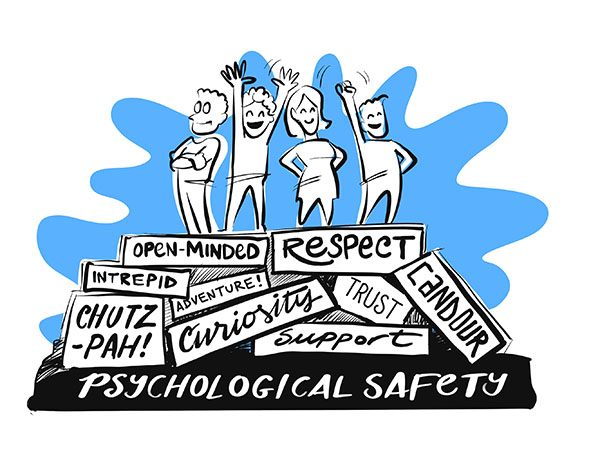Leadership experts and practioners from Patrick Lincioni (author of The Advantage: Why Organizational Health Trumps Everything Else In Business) to Ed Catmull (President of Pixar and Disney Animation, and author of Creativity, Inc.) all seem to agree: a signal of organizational health and necessary condition of team and organizational effectiveness is employees’ ability to speak candidly and be heard.
This is called psychological safety: the ability to speak up and take risks without negative repercussion.
Current State of Psychological Safety
Naturally, the degree of psychological safety within organizations and teams is going to vary.
Across my consulting engagements, I generally observe the following:
- Organizational leaders are strongly promoting psychological safety and the openness and candor that comes with it, knowing that it leads to greater productivity, innovation, and creativity
- Very few teams have a culture of psychological safety
In other words, there is generally a gap between what organizations want and what currently exists.

How do we close the gap?
First, what not to do: tell people to create a psychologically safe environment or force “tough” conversations.
To understand how to create a psychologically safe environment, we must go to the foundation of psychological safety: open mindsets. This differs from the alternative, closed mindsets.
Check out this blog post to learn if you have more of an open or closed mindset.
In fact, in most organizations I work with, they dominantly have a closed mindset (usually about 55-60% of leaders have a closed mindset). And, it is relatively rare to have leaders with a strong open mindset (usually only about 15% of leaders).
Why do so many leaders have a closed mindset?
Simply put, they generally believe that what they know is best. Unfortunately, overconfidence runs rampant among leaders.

When they believe that what they know is best, they:
- Want to be seen as being right
- Want to be the one with the answers
- Don’t want to admit they might be wrong
- Avoid feedback and new perspectives
- See disagreement as an obstacle or threat
What is the value of an open mindset?
When leaders have an open mindset, they are able to put their ego aside and believe that they may not know what is best. They recognize that they may have blind spots.
When they leave room for the possibility of being wrong, this changes what the leader values. Instead of valuing being seen as being right, they prioritize thinking optimally and finding truth. This leads them to:
- Ask questions rather than provide answers
- Be willing to admit that they are wrong
- Invite feedback and new perspectives
- See disagreement as an opportunity to learn and think more optimally and creatively
Only when open mindsets are present can psychological safety exist.
Shifting Mindsets from Closed to Open
So, if you are an organization that wants more openness and psychological safety, how do you go about shifting the mindsets of your leaders from closed to open?
I think one of the best ways is to use an analogy of our mind as a bucket.
When we have a closed mindset, we believe that our bucket is full. Thus, when water, or new knowledge, is poured into the bucket, it is not able to be captured, it overflows, and is lost.

To develop more of an open mindset, we need to help leaders change their story about the amount of available space in their bucket to allow room for new information and ideas.
This leaves two options:
- Help leaders reduce the perceived level of water currently in their bucket (they are not the experts they think they are)
Or even better:
- Help leaders see that the size of the bucket itself is likely much bigger than they originally thought (while they might know a lot, there is still a lot left to learn)

If we can help leaders go from a full bucket (“I know it all”) to less-than-capacity bucket (“I have yet to tap the vast potential of my knowledge and understanding”), they will naturally take on more of an open mindset.
What are the mindsets in your organization?
If you want to assess the degree to which your leaders have open mindsets, consider this opportunity to assess the current mindsets of your leaders and receive a collective mindset report: Collective Mindset Report












